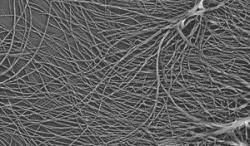Until recently, the oldest evidence of biological material on Earth came from fragments of ancient protein found in Tyrannosaurus Rex dinosaur fossils, dated at 68 million years old. But scientists from the University of North Carolina have found even more ancient biological material — cellulose microfibers—that date to over 250 million years old. These samples of cellulose were found in pristine ancient salt deposits deep beneath the New Mexico desert. This finding comes on the heels of researchers finding huge salt deposits on Mars with the Odyssey orbiter, as well as the Mars Exploration Rover Spirit finding a patch of bright soil that’s believed to be rich with salt. Combined, these findings may help point out destinations for future Mars missions looking for past life on the Red Planet.
“In looking for evidence of life on Mars, for bacteria or higher plants that existed on Mars or another planet in the solar system, then looking for cellulose in salt deposits is probably a very good way to go,†said Jack D. Griffith, Ph.D., from UNC who found the cellulose microfibers. “Cellulose appears to be highly stable and more resistant to ionizing radiation than DNA. And if it is relatively resistant to harsh conditions such as those found in space, it may provide the ideal ‘paper trail’ in the search for life on other planets.â€
Cellulose is the major structural component of plant matter and is very tough and resilient. Cellulose is one of the most abundant biological materials on Earth, with plants, algae and bacteria generating an estimated 100 gigatons each year.
The salt samples retrieved by Griffith are from an underground repository for nuclear waste, about 2,000 feet below the surface. In examining the content of fluid salt and salt crystals with an electron microscope, Griffith and his team found abundant cellulose microfibers that were “remarkably intact.â€
The cellulose microfibers were as small as five nanometers in diameter, but also, there were tangles of the fibers, creating ropes and mats . “The cellulose we isolated from the ancient salt deposits is very much like real, modern day cellulose: it looks like cellulose, behaves like cellulose, it’s chopped up by the same enzymes that cut modern day cellulose and it’s very intact,†Griffith said.
Griffith said DNA was also was observed, but in much lesser amounts than cellulose.

Whether life ever existed on Mars is the biggest scientific question driving Mars research. Scientists think the salt deposits formed on Mars approximately 3.5 to 3.9 billion years ago. “By their nature, salt deposits point to a lot of water, which potentially could remain standing in pools as it evaporates,” said Phil Christensen, principal investigator for Mars Odyssey spacecraft’s Thermal Emission Imaging System. “That’s crucial. For life, it’s all about a habitat that endures for some time.”
Whether there was enough time for biological life to develop on Mars is the big question hoped to be answered by the Phoenix mission, which will soon land on Mars’ polar region on May 25, 2008 and the future Mars Science Laboratory mission, tentatively scheduled to launch in 2009.
Original News Source: Physorg.com


Or look for fossils – they now have been found past 2.5 billion years. I think that beats 250 million by nearly a factor of 10, if my math holds up : )
Fossils are made of rock that has taken the shape of long destroyed biological material. Unless you were able to find something large enough to claim that it’s not just a rock that formed an odd shape through random natural events, you wouldn’t have much besides a cool rock. As much as I’d be fascinated to learn that they found a tyranosaurus skull on mars, I don’t think a rover’s going to dig it up all alone.
I think that Alex is referring to 2.5 billion year old fossilized bacteria.
shit i wanna fuck a hot little bitch in her little wet pussy
hunter your an idiot this is science.